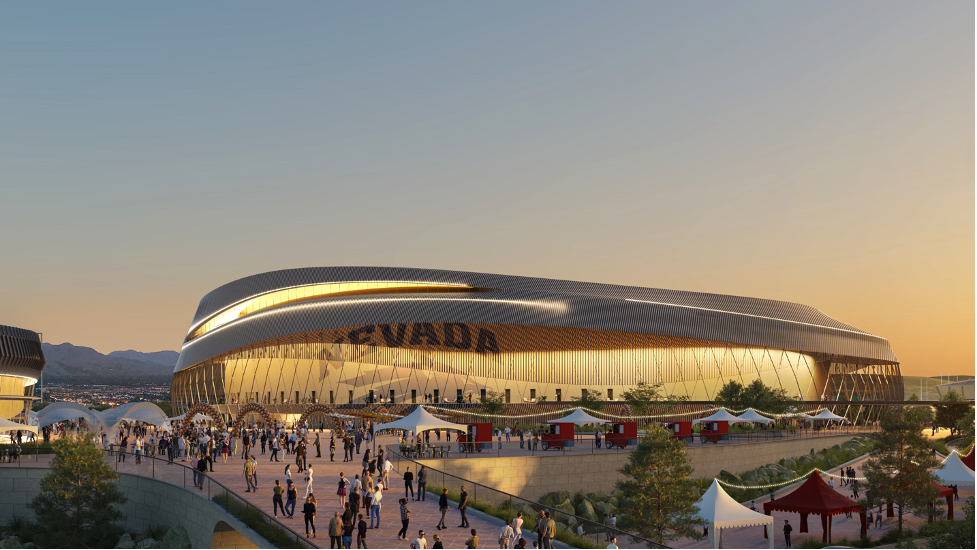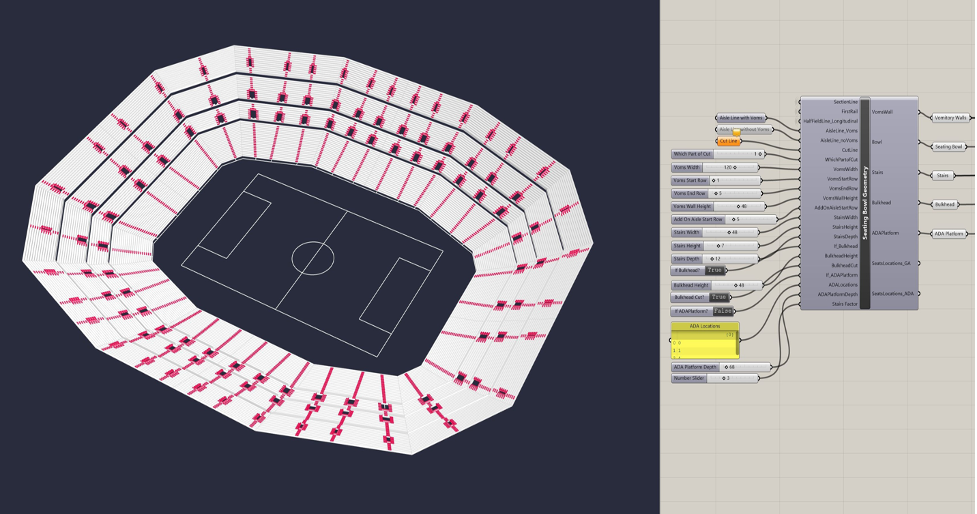As a vanguard in the intersection of architecture and technology, Rui Huang stands out in the sports architectural field with his contributions to high-profile projects, such as the Los Angeles Chargers training facility. Currently serving Gensler’s sports team as a sports architectural designer, Huang brings more than just a keen eye for design; he is a design technology specialist committed to redefining the conventional boundaries of the discipline.
Known for his pursuit of parametric design solutions, his work is at the forefront of streamlining the design process, focusing heavily on the development of seating bowls for arenas and stadiums as well as the intricate design of exterior facades. Huang’s restless quest for novel technological design methods is not just about innovation for its own sake—it is about elevating sports architecture to new heights.
Discover the unique contributions of Rui Huang to sports architecture and see how he’s elevating the field with groundbreaking technological design methods.

Launching into design
Rui Huang’s career is both an epic and a technical manual; his journey into sports architecture was fueled by a desire to craft spectacles where the vibrancy of sports could be embedded in concrete and steel. However, it wasn’t merely the allure of creating iconic structures that captivated Huang, but the potential to infuse technology into an industry ripe for evolution. Huang’s narrative goes beyond a passion for the field; it unveils a focused vision of incorporating the digital landscape into the physical.
Recalling the beginnings of his architectural quest, Huang said, “I didn’t want to just shape structures; I wanted to shape the industry’s future. I saw in every line and curve the opportunity to introduce a technological lexicon that could redefine the way we experience sports venues.”
The cultivation of this forward-thinking mindset has charted a distinct trajectory for Huang in the field of sports architecture. His designs are more than static fixtures; they are dynamic environments that respond to and enhance the experience of every visitor. Immersed in this innovative spirit, he asserts, “My journey was about more than bridging two worlds—it was about creating my own space where technology empowers design to speak in new and unexpected ways.”
Unique perspectives in design
At Gensler, Rui Huang’s methodology diverges from conventional paths, as he champions a philosophy that interlaces practicality with innovation. Competing ideas, rather than being obstacles, become harmonious elements in his hands. This distinctive angle not only marks Huang’s designs with an exclusive signature but also solidifies his reputation as an architect who transcends routine design dogmas.
“I believe what sets me apart is my relentless pursuit of fusing functionality with future-forward thinking. It’s not just about being different; it’s about being better,” clarifies Huang when discussing his work ethic. This ethos is evident in his approach towards the projects he undertakes, making every design not only a piece of artistry but also a beacon of progress in the architectural world.
Pioneering parametric design solutions
Rui Huang’s work in parametric design has significantly improved design efficiency by transforming complex data into optimal solutions. He openly discusses the challenges of innovating in sports architecture, highlighting the blend of cultural and technical shifts needed.
“The transition to parametric design was as much about cultural change as it was about technical mastery. I had to juxtapose the fluidity of aesthetics with the rigidity of algorithms,” Huang explains. This approach has led to the creation of stadiums and arenas that are precise and adaptable to their unique requirements.
Huang shares insights into his meticulous process: “I remember countless hours spent refining algorithms, ensuring that each parametric model wasn’t just a theoretical construct but a practical tool.” He views every challenge as an opportunity to advance the field, emphasizing the synergy between evolving technology and architectural creativity. “Each challenge we faced was an opportunity to push the boundaries further, affirming the symbiotic relationship between evolving technology and architectural creativity.”
Huang’s journey into parametric design is marked by his efforts to balance innovative concepts with practical applications, ensuring that each line of code has a tangible impact on the built environment.

The dance of innovation and tradition
The balancing act between honoring architectural tradition and embracing technical innovation is ferried with a clear vision. This delicate symmetry binds the architect’s responsibility to heritage with their potential to forge new paths through the use of modern tools and methodologies. Huang’s philosophy on this balance eschews complexity for clarity, a nod to his belief that innovation serves as an extension of tradition, not its replacement.
Articulating his strategy, Huang shares, “In our field, there’s a delicate interplay between the old and the new. My goal is always to respect architectural heritage while pushing the envelope with technological advancements.” His work is a testament to this cohesive integration, demonstrating that traditional principles can be enhanced by modern technology to address contemporary design challenges.
“For any architect, the enduring question is how to bring together time-tested designs with the efficiency of modern technology without losing the essence of what made those traditional designs great,” Huang emphasizes. “My approach is to build on the foundation of tradition, using technology as a tool to create functional, state-of-the-art designs that remain true to their roots.”
By setting this intention, Huang not only harmonizes the breadth of his knowledge with the depth of his innovation but also ensures that his designs strike a resonant chord that echoes both past and future architectural achievements.
Unique contributions to landmark projects
Reflecting on his input to flagship projects, Huang emphasizes the significance of individual contributions. “On a project like the Chargers training facility, it’s not only about the collective effort but also about the unique imprint each designer leaves on the project,” he shares. Huang’s involvement goes further than being part of a team; he infuses projects with his distinctive expertise and forward-thinking perspective.
Huang is quick to point out, “It’s essential to bring something to the table that no one else can—an understanding of design technology that can meaningfully shift the trajectory of a project.” With Huang’s ingenuity, projects often see an infusion of progressive techniques and a distinctive edge in the competitive landscape of sports architecture.
“My goal is always to contribute something innovative, something that will push the project beyond traditional limits and make a lasting impact,” Huang states, elucidating his ethos. His contributions are frequently at the heart of the project’s identity, distinguishing them with his brand of thoughtful and precise technological integration.
What the future looks like
Looking ahead, Rui Huang’s eye is firmly fixed on the horizons of sports architecture’s future. He envisions transformative advancements that will redefine what is achievable in design and construction. In this pursuit, Huang does not just anticipate playing a role; he aims to be at the vanguard, steering the discourse and direction of future innovations.
The future Huang envisages is vibrant with potential, underscored by advancements that may today seem like the remit of science fiction. “The next evolution in sports architecture calls for a reimagining of our current paradigms,” muses Huang. “I see myself as an orchestrator of this change, leveraging technology to unfurl new possibilities and set unprecedented benchmarks in design.”
As Huang gazes back over the terrain he has traversed, he also extends a guiding hand to those embarking on their design journey. His advice to emerging designers encapsulates not only the lessons gleaned from triumphs but also the wisdom born of encounters with adversity. Huang’s mentorship reflects his dedication to nurturing new talent and bolstering the industry’s future.
“To the aspiring designers, my message is one of courage and curiosity,” advises Huang earnestly. “The path of innovation is not for the faint-hearted, but for those who dare to challenge the status quo.” His insights provide an invaluable framework for those who seek to etch their name in the annals of sports architectural design and technology, guiding them toward constructing legacies of their own.




